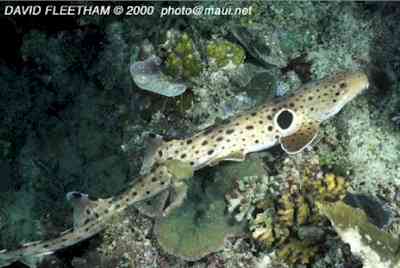What is the Smallest Species of
Shark?
Responding to a query about the smallest species of extant shark, I wrote:
As in humans, all shark species probably produce the occasional giant or dwarf. Because of their spectacular nature, tales — often unsubstantiated — of giant sharks grace the oral tradition of virtually every maritime community. But the other extreme of the shark size spectrum, reports are relatively uncommon and reliable records quite rare.
While Etmopterus hillianus is certainly among the smallest of sharks, I was not aware that this species was ever regarded as the absolute smallest. Of course, all sharks are small during the earliest part of their embryological development. Since sharks are believed to grow throughout their lives (though apparently at an ever-decreasing rate), the minimum size of a free swimming representative of a given species depends largely on how old and well-fed it happened to be at the time of capture. It seems to me that the only criterion for extremes of body size — either maximum or minimum — that has any biological significance is size at reproductive maturity.
Most people think of sharks as large animals. Yet only 10 of 465 species of sharks regularly reach a length of over 13 feet (4 metres). Most sharks, like this Epaulette Shark (Hemiscyllium ocellatum), rarely grow longer than 2 or 3 feet (60 or 100 centimetres). This raises an interesting question: How small can a shark be and still have all the features that characterize sharks?
Photo © David Fleetham david@davidfleetham.com; used with the gracious permission of the photographer.
Although there have been numerous attempts to standardize size at maturity for elasmobranchs of both sexes, wide-spread adoption of firm criteria has not yet occurred. Determining the maturity state of sharks in the field is not as simple or straight-forward as many workers imagine (see Pratt 1979, 1988, 1993, 1994, and 1996 for discussions of inherent challenges). This is especially true for non-pregnant female specimens, in which the presence of large, apparently fully-developed oocytes in the reproductive tracts is insufficient evidence of reproductive maturity and detailed histological examination of said oocytes is required to unequivocally determine their maturity state. Although it is widely thought that determination of sexual maturity in male elasmobranchs depends solely upon degree of clasper calcification, the combination of fully calcified claspers with edematous clasper tips and viable spermatozoa within the seminiferous tubules is a much more reliable method.
Based on these criteria, the smallest known extant shark species appears to be Etmopterus perryi, males of which mature at 16 to 17.5 cm TL and gravid females have been found at 19 to 20 cm TL (Springer & Burgess 1985). One 19-cm TL specimen of E. perryi was found to contain three 6-cm embryos, each bearing external gill filaments. In comparison, the smallest mature male E. hillianus examined by Schofield & Burgess (1997) was 20 cm TL. Until the discovery of E. perryi, the smallest living shark was widely considered to be Squaliolus laticaudus, males of which mature at about 15 cm TL and females at about 17 to 20 cm TL (Compagno 1984). This and other tiny squaloids are closely rivaled by the carcharhinoid Eridacnis radcliffei, males of which mature by 18 to 19 cm TL, females possibly mature at 15 to 16 cm TL.
All these diminutive sharks seem to mature at roughly the same length. Given the difficulties in determining reproductive maturity in elasmobranchs, caution is warranted in determining one species the final, absolute winner for the title of World's Smallest Living Shark. Most of the length at maturity numbers presented in the literature are estimates based on gross (superficial) examination of the urogenital tract. Due largely to energetic differences in parental investment, male elasamobranchs typically mature at a smaller size than females of the same species. Size at maturity of females is generally regarded to be more significant in limiting clutch size and in determining the likelihood of pup survival than size at maturity of males. Thus, size at maturity of female sharks seems an expedient index for comparison among species.
Since we have incontrovertable evidence that at least one 19-cm TL E. perryi carried developing embryos — unequivocal proof that this individual was, in fact, reproductively mature — I propose that this species be tentatively regarded as the smallest extant species of shark, pending more comprehensive reproductive data on its closest rivals.
Cheers,
— R. Aidan Martin
[Posted to ELASMO-L July 28, 1999]

